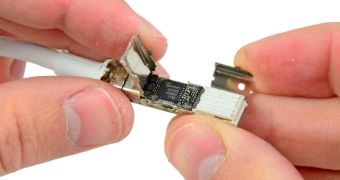After receiving word that the $50 Apple Thunderbolt cable may be an ‘active’ device, iFixit decided to put those claims to the test and do what the repair shop does best - tear it apart.
Soon after the release of Apple’s 2 meter Thunderbolt cable, iFixit learned from a reputable source that the cable may actually have chips containing firmware in it.
This, iFixit said, would make it “more expensive to produce than your garden-variety HDMI cable — thus justifying the hefty price tag.”
As it turned out, these prognostications held water.
“The cable contained a sturdy plastic sleeve on each end that looked quite suspicious. Heating up an Exacto knife worked well against the hard plastic, and we managed to remove the casing from the connector after some careful cutting/melting,” they write on their blog.
It took quite a bit of desoldering to remove the metal surrounding the connector, but once the innards were revealed, they could confirm the presence of not one, but two Gennum GN2033 chips in the connector.
Placed one on each side, “they were flanked by other, much smaller chips that surely added to the cable’s cost,” the repair shop said.
According to the tinkerers, there were also “tons of little resistors (providing impedance as needed) all around the larger chips.”
As expected, the connector found on the other end of the cable was not only identical on the outside, but also on the inside, thus more than justifying the high price Apple charges for it.
Of course, this still doesn’t sound like an excuse not to bundle the cable with products like the $1,000 Promise Pegasus R4 4TB RAID System which Apple advertises as being able to “unleash the power of Thunderbolt.”
“Pegasus is compatible with Mac systems with Thunderbolt and required [sic] Thunderbolt cable (sold separately),” reads the advert on Apple’s web store.

 14 DAY TRIAL //
14 DAY TRIAL //